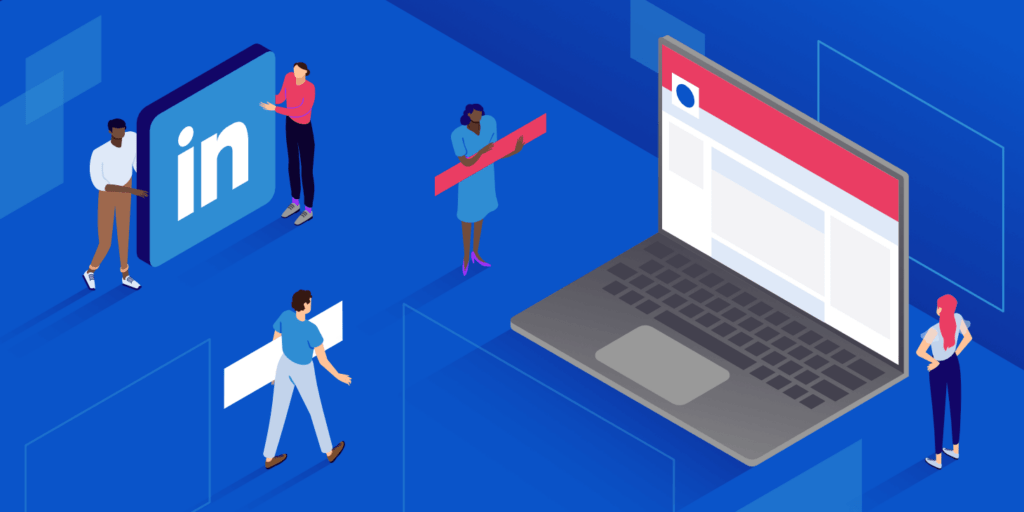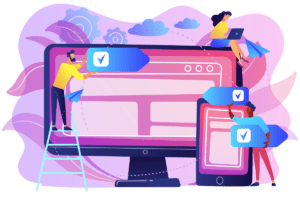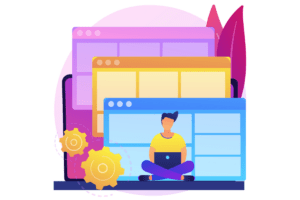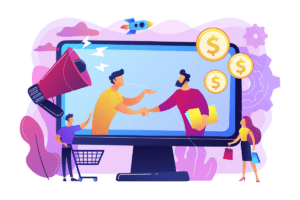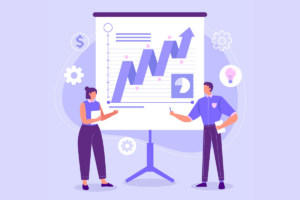LinkedIn is one of the most powerful tools that B2B companies can use. Whether you plan to use LinkedIn to advertise, social sell, or gain brand recognition, LinkedIn can be an amazing asset. But, it all starts with an optimized company LinkedIn page. Without an optimized page, you won’t get the same engagement, trust, and website visitors that you could with a fully optimized company page. Keep reading to learn how to optimize your company’s LinkedIn page to drive results.
Check Out Your Competitors
Before making any changes or updates to your own company’s LinkedIn page, I highly recommend checking out your competitor’s pages. This can give you an idea of what they are currently doing, what you like, and what you don’t like. Additionally, you can see what kind of content their followers respond the best to. Check out their description, cover image, industry that they have listed as, and other information that is on their LinkedIn page. When optimizing your own page, don’t copy theirs exactly, but use this research to see what you like and what you can improve on. Remember, you want your page to stand out amongst your competitor’s pages.
Company Profile Picture
Your company’s profile picture will be how you are immediately recognizable. In the vast majority of cases, your company should make their profile image your logo. Make it clear, centered, and not cut off at any points. We have also seen companies change their profile image based on a cause they believe. A few you may have seen include showing support for Pride Month or Ukraine, like shown below. This can help your company seem more personable and relatable, while showing your support to important causes.
Cover Photo
Next up on the list, your LinkedIn cover photo. This is what will catch your viewer’s attention, and keep them enticed so they read what you’re all about below. Your cover photo should be aligned with your brand’s colors, and make sense with what your company stands for. Above, you can see how we have used our short slogan, with an animation that draws attention downwards. All while explaining what we do as a company. You may not think that a cover photo is as important as information, but it is one of the first things that your LinkedIn page visitors will see.
Overview
After your company’s graphics, you’ll need to perfect your overview and company information. You’ll give your company a brief overview, including key features, an enticing statistic, and/or any noteworthy clients. This is how you will pique their interest, and make them want to click on the link to your website that is just below the overview. After that, you will include your company’s industry, size, headquarters, when you were founded, and any specialties that you focus on. In this section, it can be helpful to refer to your competitors if you get stuck.
Add a CTA Button
When a visitor is on your company’s LinkedIn page, you want to make it as easy as possible for them to convert. So, it’s essential to include a call to action button on your page. You can change your button to say sign up, learn more, contact us, visit website, or register, depending on your company goals. For example, if you are trying to encourage sign ups for your company’s upcoming webinar, you can update your button to say “register” instead of your usual button.
Post Quality & Consistently
After your profile is set up, you’re ready to start posting content. When you are sharing content to your company’s LinkedIn page, try to post on a consistent schedule. This doesn’t necessarily mean at the same time every day, moreso the same number of posts per week. If you post once one week, and seven times the next, that could confuse your followers and they might even unfollow. In addition to posting consistently, you’ll want to share a variety of content. This could include video tutorials, video series, blog articles, quotes, announcing new features, and employee achievements. This will ensure that your followers don’t get bored, and all of their needs are met.
Omnichannel Marketing
Whether you are just creating your LinkedIn page, or you are coming up with new content to share with your audience, you want to ensure that they align with your brand. This concept is also referred to as omnichannel marketing. Think of how confused your LinkedIn leads would be if they saw an ad for your company that had very neutral colors, a calming font, and then they click on it to be taken to a website that is bright red. That lead will likely bounce, as they’ll think that they misclicked.
Employee LinkedIn Pages
If your employees are on LinkedIn and have your company listed in their profile, they should ensure that their profile is appropriate. We’ve all seen those comments on posts where people are bashing another company. If a lead sees this, especially if you focus on social selling, this can turn them off of your company. On the other hand, this is a great opportunity for your employees to also include branding on their own LinkedIn page. They can use a LinkedIn cover photo that represents your brand and include a company tagline in their headline.
Invite People to Follow Your Company’s LinkedIn Page
Just like any other social media channel, it can be hard to grow your LinkedIn channel organically. But, LinkedIn has a feature where you can invite your connections to follow your page. Having followers will make your company look more reputable and trustworthy, especially if you plan to advertise. To do this, navigate to your company’s LinkedIn page. On the right hand side, you will see a block saying “Grow Your Followers”. Simply click on the “Invite Connections” button, and send invitations to your connections. LinkedIn recently increased their max number of invitations that you can send from 100 to 250.
Lead Gen Forms
Lead generation forms are a relatively new feature to LinkedIn pages. Upgrade your LinkedIn message ads and sponsored content with forms to help you fill your CRM with hot leads. In fact, 90% of their pilot customers improved on their cost per lead goals, with lower CPLs compared to standard LinkedIn ads. Lead gen forms come pre-filled with accurate LinkedIn profile data, which allows users to submit their information in just a few clicks. You can take advantage of lead gen forms within your LinkedIn Campaign Manager.
LinkedIn Page Analytics
Along the top of your company’s LinkedIn page, you will see a tab for analytics. Under this tab, you will be able to see a variety of analytics based on your page. Below are a few of my favorite LinkedIn page analytics to keep tabs on.
Visitor Analytics
The first LinkedIn analytic that you should watch is your page visitor analytics. You want to ensure that your LinkedIn page is attracting the right audience. Use this to gain insight into who is visiting your page. View job function, company size, industry, location, and the seniority of your page visitors. If you see that a large percentage of your visitors are from an industry that you don’t cater to, then it might be a good idea to switch up your content to try and attract more visitors in your preferred industry. You can also see which of your LinkedIn pages are viewed the most. You can use this stat to help you know when to switch up your content, like giving your About section a refresh.
Competitor Analytics
One of the most helpful LinkedIn page analytics is competitor analytics. Simply enter in your competitors, and this section will populate with their total followers, new followers, organic engagements, and their number of recent organic posts. These analytics can help you see where your company should be in comparison. As an example, if you see that all of your competitors have 10-15 recent posts, but you only have 5, it might be a good idea to post more frequently as well.
Update Analytics
Under the Update tab, you will see your page highlights, interaction metrics, and a breakdown of each post’s metrics. You are also able to compare metrics of your organic and paid advertising, including impressions, reactions, clicks, and engagement rate. It is helpful to view how each post performs, so you know what type of content your followers respond the best to. You can easily export these metrics to track and compare months and years even easier.
Keep Tabs on Industry Leaders
Similar to checking out your competitor’s LinkedIn pages, it can be helpful to take a look at industry leaders. A few examples of great LinkedIn pages by industry leaders are Hubspot, Figma, and my personal favorite, Mailchimp. All of these pages can give you inspiration on what to share on your own company’s LinkedIn page. You will also see them using new features that LinkedIn releases before most other companies.
Want to Know What Companies Visit Your Website From LinkedIn?
The primary purpose of social media marketing as a B2B company is to generate qualified website visitors with the hopes of turning them into clients. Wouldn’t it be nice if you could see which companies are visiting your website from not just LinkedIn, but Google Ads, Facebook, email campaigns, and more? With the help of Visitor Queue, identify the companies that visit your website along with their visit information like how they were acquired, pages viewed, and how long they spent on each page. We also provide employee contact information to help you reach out. You can use their website visit information to help you better frame your pitch. Start your 14-day free trial of Visitor Queue today and stop losing leads.
Final Words
In this day and age, LinkedIn is almost essential for B2B companies. LinkedIn is one of the best tools that your company can use. Whether you are looking to social sell, advertise, post organically, or a combination of all three, it is a great asset to B2B marketers. Your company’s LinkedIn page can help you build brand awareness, recognition, and help you stand out from your competition. If you have any questions about how Visitor Queue can help your company, don’t hesitate to reach out.
 Identify
Identify Personalize
Personalize Benchmark
Benchmark Agencies
Agencies Integrations
Integrations Case Studies
Case Studies Use Cases
Use Cases Blog
Blog Resources
Resources